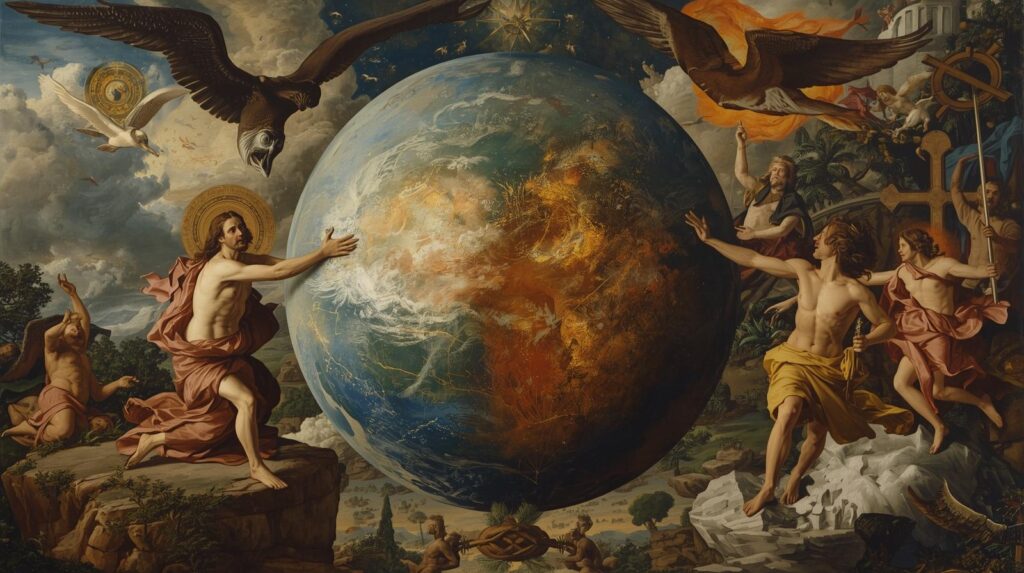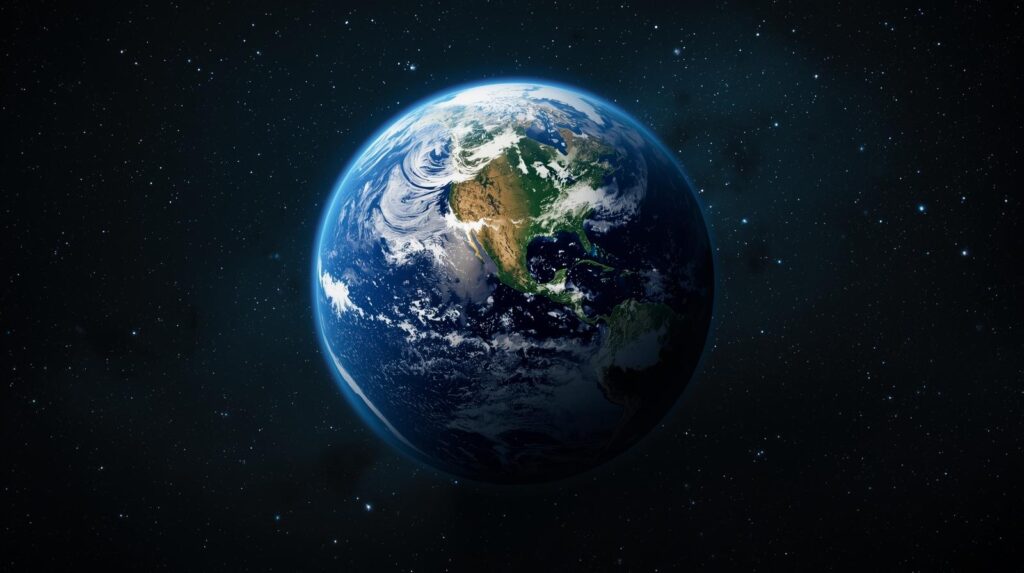Age of Earth – Science vs. Religion
How old is our planet? What is the age of Earth? It’s a question that sparks curiosity in classrooms, churches, and labs alike. Some say billions of years, others thousands. Science and religion often give different answers, each with its own logic and evidence. If you’re wondering how old the Earth is according to science or what the Bible says compared to science, let’s break it down.
What Is the age of Earth according to Science?
Scientists estimate the age of Earth to be about 4.54 billion years old. That’s 4,540,000,000 years—a number so big it’s like trying to count every grain of sand on a beach. How did they figure this out? It’s not a guess; it’s based on clues from rocks, space, and even ice.
One key method is radiometric dating, like a clock inside rocks. Certain elements, like uranium, slowly turn into lead over time. This happens at a steady pace, called a half-life. For uranium-238, half of it becomes lead in 4.5 billion years. By checking how much uranium and lead are in a rock, scientists calculate its age. They test the oldest rocks on Earth, like ones in Canada, and get dates around 3.8 to 4 billion years. Tiny zircon crystals from Australia push it even further, to 4.4 billion years.

But Earth’s rocks aren’t the only evidence. Meteorites, chunks from space, date to about 4.6 billion years. Moon rocks brought back by astronauts match that age too. These are clean samples, untouched by Earth’s weather or volcanoes, so they’re like a snapshot of the solar system’s start. Scientists also know the universe is about 13.8 billion years old, based on things like the Big Bang’s leftover radiation. That gives plenty of time for Earth to form from dust and gas circling a young sun.
Other clues back this up. Ice cores from places like Greenland show layers going back over 100,000 years, each layer marking a year’s snowfall. Tree rings from ancient pines count back 10,000 years or more. Even coral reefs grow in patterns that show long timelines. These methods all agree, like different witnesses telling the same story.
Back in the day, people had wilder guesses. In the 1800s, a scientist named Lord Kelvin thought Earth was 20 to 400 million years old, based on how long a hot planet would take to cool. He was wrong, but it was a start. Then geologists studied rock layers, like in cliffs or canyons, noticing older rocks sit deeper. This idea, called stratigraphy, showed Earth’s history is long, but it couldn’t give exact years until radiometric dating came along.
Science keeps checking itself. If one test gives a weird result, they try others, like dating with potassium or carbon. Mistakes happen—weather can mess up rocks—but the big picture stays solid: Earth is ancient.
How Old Is the Earth According to the Bible?
Now let’s look at the religious side, especially the Bible, since many ask how old the Earth is according to the Bible and science. Some Christians who read the Bible literally say Earth is 6,000 to 10,000 years old. This comes from adding up ages in the Bible’s genealogies, like from Adam to Noah to Abraham. A bishop named James Ussher did this in the 1600s and said creation happened in 4004 BC—about 6,000 years ago.
The Bible’s Book of Genesis describes God making the world in six days, resting on the seventh. Each day ends with “evening and morning,” which many take as regular 24-hour days. The Hebrew word “yom” usually means a day, and the numbered days—first, second, third—suggest a normal week. Exodus 20:11 ties the Sabbath to this creation week, so some say it must be literal days.
This young Earth view often includes Noah’s flood as a big event. Fossils, canyons, and rock layers? They say these formed fast during a worldwide flood, not over millions of years. Groups like Answers in Genesis argue this, pointing to things like dinosaur bones with soft tissue or coal forming quickly in labs as proof science might be off.
But not every Christian agrees. Some see Genesis as symbolic, not a science textbook. The “day-age” idea says each creation day could be millions of years, since “yom” can mean a long period elsewhere in the Bible. Psalms 90:4 says a thousand years are like a day to God. Another idea, the gap theory, suggests a long time passed between Genesis 1:1 and 1:2, where an older world was remade. Progressive creationism has God shaping life over eons, fitting with science.

Other faiths have their own views. Hinduism talks about cycles lasting billions of years, which aligns more with science. In Islam, the Quran’s “days” of creation can mean long periods, not just 24 hours. Judaism varies—some stick to a young Earth, others see the Torah as flexible on time.
Where Science and Religion Clash
So, how do these views stack up? Science says 4.54 billion years, built on measurable evidence like rock ages and starlight traveling from galaxies billions of light-years away. Religion, especially young Earth views, starts with faith in sacred texts like the Bible. Here’s where they bump heads.
Young Earth believers challenge science’s dating methods. They say radiometric dating assumes decay rates never change or that rocks weren’t contaminated. Maybe the flood sped things up, they argue. But scientists test for contamination and find consistent results across methods. If decay rates changed that much, Earth would’ve overheated from the energy released.
Starlight’s a tough one too. We see light from stars billions of years away—how, if the universe is only 6,000 years old? Some say God made the light already in transit or that time worked differently during creation. That’s hard to test, though, and feels like a stretch to some.
Science also points to fossils, like dinosaurs from 66 million years ago, or human remains from 300,000 years back. Young Earth views say these fit in a short timeline, maybe with dinosaurs living alongside people before the flood. They point to rare finds, like soft tissue in fossils, as hints of a younger Earth. Scientists counter that such tissue can preserve under special conditions, not proof of recent dinosaurs.
Old Earth religious folks try to bridge the gap. They say the Bible teaches who made the world, not how long it took. Early thinkers like Augustine, from the 400s, didn’t read Genesis literally. Modern scientists who are Christians, like Francis Collins, see no conflict—God set up a universe with laws that led to a 4.54-billion-year-old Earth.
Real-World Examples
Let’s picture it. The Grand Canyon’s a great example. Science says the Colorado River carved it over 5-6 million years, cutting through rock layers built over hundreds of millions. Young Earth folks say the flood did it in months, with massive water flows laying down and carving layers fast.
Or take human history. Science finds ancient tools and bones, like in Africa, dating back tens of thousands of years. Young Earth views squeeze this into a few thousand years, saying early humans lived longer or timelines are misread. But carbon dating, good for up to 50,000 years, keeps showing older dates for artifacts.
Then there’s the universe. Telescopes see galaxies formed billions of years ago. If the Earth is young, why do we see such old light? It’s a puzzle that science answers with a long timeline, while some religious views lean on divine creation of light or time shifts.
Why It Matters
This debate isn’t just for fun—it shapes how we teach kids, make laws, and view the world. In schools, some push for creationism alongside evolution. Courts often say that’s religion, not science, so it stays out of public classrooms. But discussing both helps people think critically.
For an 8th grader, it’s okay to feel torn. Science uses tools like microscopes and math to measure the past. Religion offers stories and meaning, like why we’re here. Some say they don’t mix—science is about facts, faith is about belief. Others say they do, like a scientist who prays and sees God’s hand in nature’s laws.
Bridging the Gap
Can these views get along? Some try. Old Earth creationists accept science’s timeline but say God guided it. Theistic evolution says God used evolution to shape life. Others keep them separate—science for how, religion for why. A young Earth believer might dig into science to challenge it, while a scientist might respect faith but stick to data.
If you’re curious, explore both. Read about rocks, try a fossil dig, or ask a pastor about Genesis. Science builds on evidence, like layers in a cliff. Faith builds on trust in something bigger. Neither has to win—maybe they both teach us something.
Wrapping It Up
So, how old is the Earth? Science says 4.54 billion years, backed by rocks, stars, and ice. The Bible, for some, says 6,000 to 10,000 years, based on Genesis and faith. Others blend the two, seeing long ages in scripture. It’s a big question with no single answer yet. Keep asking, keep digging, and you might find your own way to see it.
